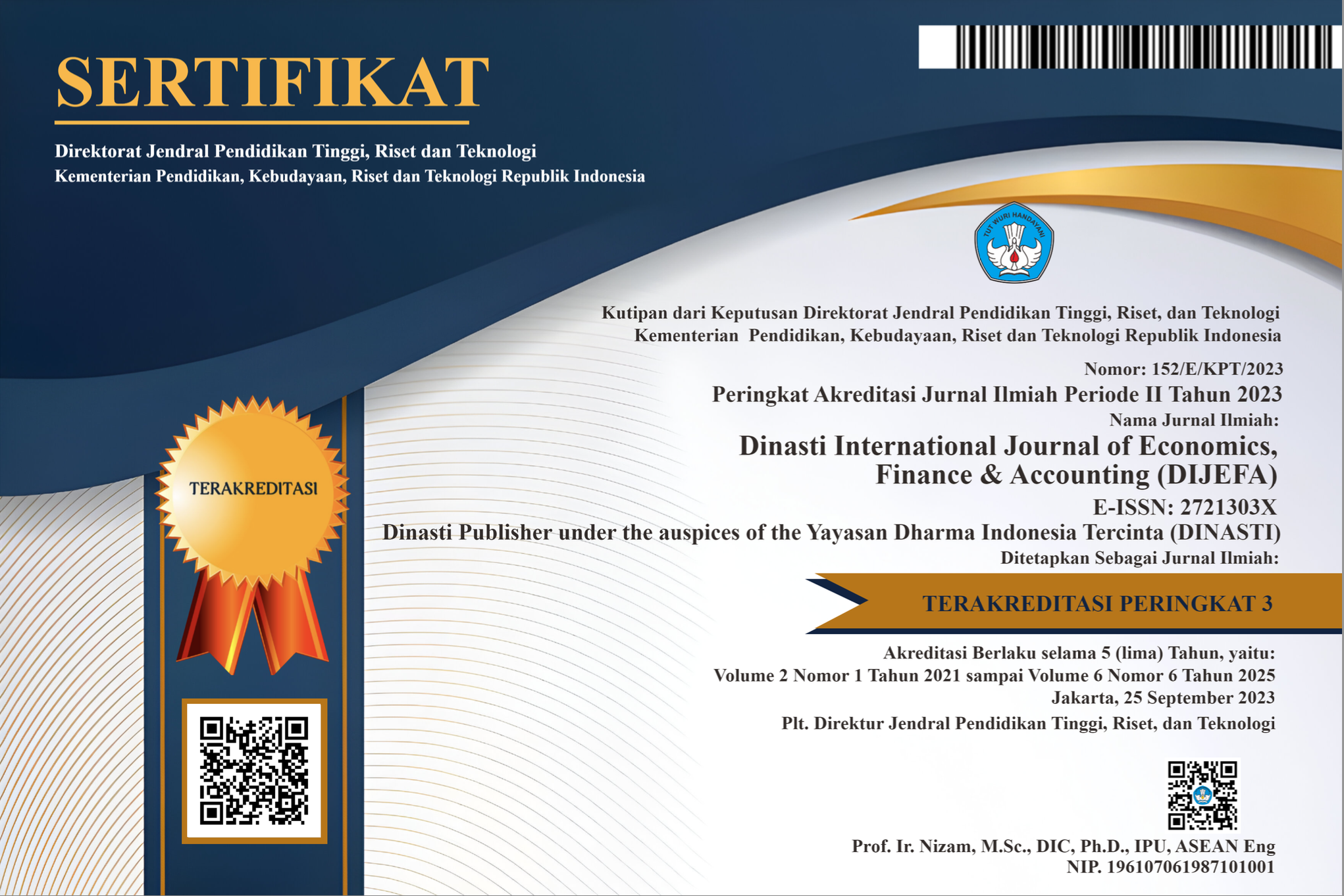The Role of Loan Loss Provisions in Competition Toward Bank Stability
DOI:
https://doi.org/10.38035/dijefa.v5i2.2661Keywords:
Competition, Stability, Loan Loss Provision, VAR/VECM, moderated regressionAbstract
This study investigates how competition and loan loss provisions (LLP) affect stability by including the variable of LLP as a moderating factor introduced as a new variable in the research framework. This study used panel data from 2012 to 2021 from Indonesia's largest banks by assets. This study will analyze competitiveness, loan loss provision, and stability using moderated regression. This study determined long-term and short-term results using VAR/VECM. At the short-term level, competition did not significantly affect stability, while stability had a more significant effect on competition. However, increased competition seems to improve banking stability in the long run. The role of allowance of impairment losses varies depending on the period, with its negative impact on stability in the short-term. This study uses loan loss provision (LLP) as a moderating variable to examine the extent to which competition enhances stability. Internal banking policies must strengthen understanding of the impact of loan loss provisions and ensure effective risk management practices. In addition, banks must consider long-term strategies in managing competition by maintaining a balance between healthy competition and sound risk management to achieve long-term stability.
References
Adrian, T., & Shin, H. S. (2008). Financial intermediaries, financial stability, and monetary policy. FRB of New York Staff Report, 346. https://doi.org/10.2139/ssrn.1266714
Agénor, P.-R., & Da Silva, L. P. (2017). Cyclically adjusted provisions and financial stability. Journal of Financial Stability, 28, 143–162. https://doi.org/10.1016/j.jfs.2016.12.009
Albaity, M., Mallek, R. S., & Noman, A. H. M. (2019). Competition and bank stability in the MENA region: The moderating effect of Islamic versus conventional banks. Emerging Markets Review, 38, 310–325. https://doi.org/10.1016/j.ememar.2019.01.003
Azmi, W., Anwer, Z., Ali, M., & Mohamad, S. (2024). Competition, stability, and institutional environment: The case of dual banking economies. International Journal of Finance & Economics, 29(1), 609–631. https://doi.org/10.1002/ijfe.2700
Boyd, J. H., & De Nicolo, G. (2005). The theory of bank risk taking and competition revisited. The Journal of Finance, 60(3), 1329–1343.
Chiaramonte, L., Croci, E., & Poli, F. (2015). Should we trust the Z-score? Evidence from the European Banking Industry. Global Finance Journal, 28, 111–131. https://doi.org/10.1016/j.gfj.2015.02.002
Chinoda, T., & Kapingura, F. M. (2023). The impact of digital financial inclusion and bank competition on bank stability in sub-Saharan Africa. Economies, 11(1), 15. https://doi.org/10.3390/economies11010015
Clark, E., Radi?, N., & Sharipova, A. (2018). Bank competition and stability in the CIS markets. Journal of International Financial Markets, Institutions and Money, 54, 190–203.
Cobbinah, J., Zhongming, T., & Ntarmah, A. H. (2020). Banking competition and stability: evidence from West Africa. National Accounting Review, 2(3), 263–284.
Collins, W. J., & Shaw, R. D. (1995). Geochronological constraints on orogenic events in the Arunta Inlier: a review. Precambrian Research, 71(1–4), 315–346. https://doi.org/10.1016/0301-9268(94)00067-2
Corbae, D., & Levine, R. (2019). Competition, stability, and efficiency in the banking industry. Manuscript, University of Wisconsin, 8.
Dutta, K. D., & Saha, M. (2020). Nonlinearity of competition-stability Nexus: evidence from Bangladesh.
El Moussawi, C., & Mansour, R. (2022). Competition, cost efficiency and stability of banks in the MENA region. The Quarterly Review of Economics and Finance, 84, 143–170. https://doi.org/10.1016/j.qref.2021.12.005
Elzinga, K. G., & Mills, D. E. (2011). The Lerner index of monopoly power: origins and uses. American Economic Review, 101(3), 558–564. https://doi.org/10.1257/aer.101.3.558
Feinberg, R. M. (1980). The Lerner index, concentration, and the measurement of market power. Southern Economic Journal, 1180–1186. https://doi.org/10.2307/1057252
Fiordelisi, F., & Mare, D. S. (2014). Competition and financial stability in European cooperative banks. Journal of International Money and Finance, 45, 1–16. https://doi.org/10.1016/J.JIMONFIN.2014.02.008
Fu, X. M., Lin, Y. R., & Molyneux, P. (2014). Bank competition and financial stability in Asia Pacific. Journal of Banking & Finance, 38, 64–77. https://doi.org/10.1016/j.jbankfin.2013.09.012
Ghassan, H. B., & Guendouz, A. A. (2019). Panel modeling of z-score: evidence from Islamic and conventional Saudi banks. International Journal of Islamic and Middle Eastern Finance and Management, 12(3), 448–468. https://doi.org/10.1108/IMEFM-04-2018-0122
Ghenimi, A., Chaibi, H., & Omri, M. A. B. (2017). The effects of liquidity risk and credit risk on bank stability: Evidence from the MENA region. Borsa Istanbul Review, 17(4), 238–248. https://doi.org/10.1016/j.bir.2017.05.002
Hamidah, F. K., Tristiarini, N., Minarso, B., & Prajanto, A. (2023). Pengaruh Kinerja Keuangan Terhadap Profitabilitas Bank Umum Indonesia di Masa Pandemi Covid-19. Jurnal Riset Terapan Akuntansi, 7(1), 52–64.
Hope, C. J., Gwatidzo, T., & Ntuli, M. (2013). Investigating the effect of bank competition on financial stability in ten African countries. International Business & Economics Research Journal, 12(7), 755–767. https://doi.org/10.19030/iber.v12i7.7968
Ijaz, S., Hassan, A., Tarazi, A., & Fraz, A. (2020). Linking bank competition, financial stability, and economic growth. Journal of Business Economics and Management, 21(1), 200–221. https://doi.org/10.3846/jbem.2020.11761
Irawati, I., & Sihotang, M. K. (2023). Menganalisis Pengaruh Non-Performing Financing (NPF), Kewajiban Penyediaan Modal Minimum (KPMM), dan Financing to Deposit Ratio (FDR) Terhadap Cadangan Kerugian Penurunan Nilai (CKPN) pada Perbankan Syariah di Indonesia. Ekonomi, Keuangan, Investasi Dan Syariah (EKUITAS), 5(1), 289–297.
Kabir, M. N., & Worthington, A. C. (2017). The ‘competition–stability/fragility’nexus: A comparative analysis of Islamic and conventional banks. International Review of Financial Analysis, 50, 111–128. https://doi.org/10.1016/j.irfa.2017.02.006
Kasir, K. (2020). PENGARUH CAR, BOPO DAN CKPN TERHADAP ROA PADA PERBANKAN PEMERINTAH TAHUN 2014–2018. Jurnal Indonesia Membangun, 19(1), 1–15.
Khan, H. H., Kutan, A. M., Naz, I., & Qureshi, F. (2017). Efficiency, growth and market power in the banking industry: New approach to efficient structure hypothesis. The North American Journal of Economics and Finance, 42, 531–545.
Kocisova, K., Gavurova, B., & Behun, M. (2018). The evaluation of stability of Czech and Slovak banks. Oeconomia Copernicana, 9(2), 205–223.
Laeven, L., & Majnoni, G. (2005). Does judicial efficiency lower the cost of credit? Journal of Banking & Finance, 29(7), 1791–1812. https://doi.org/10.1016/j.jbankfin.2004.06.036
Lepetit, L., & Strobel, F. (2015). Bank insolvency risk and Z-score measures: A refinement. Finance Research Letters, 13, 214–224. https://doi.org/10.1016/j.frl.2015.01.001
Leroy, A., & Lucotte, Y. (2017). Is there a competition-stability trade-off in European banking? Journal of International Financial Markets, Institutions and Money, 46, 199–215.
Liu, H., Molyneux, P., & Wilson, J. O. S. (2013). Competition and stability in European banking: a regional analysis. The Manchester School, 81(2), 176–201. https://doi.org/10.1111/j.1467-9957.2011.02285.x
Mahieux, L., Sapra, H., & Zhang, G. (2023). CECL: Timely loan loss provisioning and bank regulation. Journal of Accounting Research, 61(1), 3–46. https://doi.org/10.1111/1475-679X.12463
Maudos, J., Villarroya, J. M., de Guevara, J. F., & de Guevara Radoselovics, J. F. (2014). Endeudamiento de las empresas españolas en el contexto europeo: el impacto de la crisis. Fundacion BBVA.
Minsky, H. (2016). Can it happen again?: Essays on instability and finance. Routledge. https://doi.org/10.4324/9781315625607
Muizzuddin, M., Tandelilin, E., Hanafi, M. M., & Setiyono, B. (2021). Does institutional quality matter in the relationship between competition and bank stability? Evidence from Asia. Journal of Indonesian Economy and Business, 36(3), 283–301. https://doi.org/10.22146/jieb.v36i3.1428
Nelson, O. N. F. (2020). The Impact of credit risk management on the profitability of a commercial bank: The case of BGFI bank Congo. International Journal of Economics and Finance, 12(3), 21. https://doi.org/10.5539/ijef.v12n3p21
Ngaira, A. P., & Miroga, J. (2018). Determinants of financial stability of listed commercial banks in Kenya. The Strategic Journal of Business & Change Management, 5(4), 1074–1097.
Ozili, P. K., & Outa, E. (2017). Bank loan loss provisions research: A review. Borsa Istanbul Review, 17(3), 144–163.
Prena, G. Das, & Nareswari, S. K. D. (2022). Pengaruh Penerapan PSAK 71, BOPO dan NPL Terhadap Profitabilitas Pada Perbankan yang Terdaftar di BEI. WACANA EKONOMI (Jurnal Ekonomi, Bisnis Dan Akuntansi), 21(2), 175–184. https://doi.org/10.22225/we.21.2.2022.175-184
Risfandy, T., Tarazi, A., & Trinugroho, I. (2022). Competition in dual markets: Implications for banking system stability. Global Finance Journal, 52, 100579. https://doi.org/10.1016/j.gfj.2020.100579
Spierdijka, L., & Zaourasa, M. (2018). Measuring banks’ market power in the presence of economies of scale: A scale-corrected Lerner index. Journal of Banking & Finance, 87, 40–48. https://doi.org/10.1016/j.jbankfin.2017.09.022
Srivastava, B., Singh, S., & Jain, S. (2023). Bank competition, risk-taking and financial stability: insights from an emerging economy. Competitiveness Review: An International Business Journal, 33(5), 959–992. https://doi.org/10.1108/CR-10-2021-0143
Yensu, J., Yusif, H. M., Tetteh, E., Asumadu, G., & Atuilik, D. A. (2021). Main determinants of banks’ stability: Evidence from commercial banks in Ghana. Journal of Finance and Economics, 9(2), 42–52. https://doi.org/10.12691/jfe-9-2-1
Downloads
Published
How to Cite
Issue
Section
License
Copyright (c) 2024 Chajar Matari Fath Mala

This work is licensed under a Creative Commons Attribution 4.0 International License.
Authors who publish their manuscripts in this journal agree to the following conditions:
- The copyright on each article belongs to the author(s).
- The author acknowledges that the Dinasti International Journal of Economics, Finance & Accounting (DIJEFA) has the right to be the first to publish with a Creative Commons Attribution 4.0 International license (Attribution 4.0 International (CC BY 4.0).
- Authors can submit articles separately, arrange for the non-exclusive distribution of manuscripts that have been published in this journal into other versions (e.g., sent to the author's institutional repository, publication into books, etc.), by acknowledging that the manuscript has been published for the first time in the Dinasti International Journal of Economics, Finance & Accounting (DIJEFA).


























































